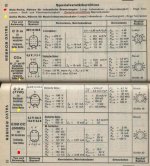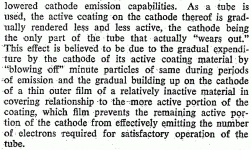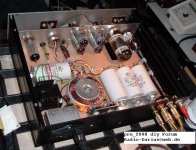Hello,
I am using a 6080WC at the input of my preamp. Anode current is 800µA per section.
Anode dissipation is 10mW per section. Since this is fairly low for a 6V3 2A5 heater,
does this cause deterioration of the emission surface?
Or does deterioration only happen if cathode current is switched off completely?
Does the WC have a protection against deterioration of the emission surface?
What do you think?
Kind regards,
Darius
I am using a 6080WC at the input of my preamp. Anode current is 800µA per section.
Anode dissipation is 10mW per section. Since this is fairly low for a 6V3 2A5 heater,
does this cause deterioration of the emission surface?
Or does deterioration only happen if cathode current is switched off completely?
Does the WC have a protection against deterioration of the emission surface?
What do you think?
Kind regards,
Darius
Thanks for the replies.
It's not poisoned, this is another effect.
I don't know the English word for Zwischenschichtbildung.
I think this happens at no current and does not happen at low current, I don't know.
I am going to measure the apparatus sporadic and will see what happens ...
Kind regards,
Darius
It's not poisoned, this is another effect.
I don't know the English word for Zwischenschichtbildung.
I think this happens at no current and does not happen at low current, I don't know.
I am going to measure the apparatus sporadic and will see what happens ...
Kind regards,
Darius
It's an interesting paragraph in your link Darius!
Zwischenschichtbildung means "formation of interstitial layer" judging from the description.
It suggests that "when the cathode is heated, but no anode current yet flows, a layer forms between the cathode carrier and the active layer, and causes a reduction in emission". The author claims this is a typical limiting factor to a valve's lifetime.
I have not heard of this process before, but would like to know more...
Zwischenschichtbildung means "formation of interstitial layer" judging from the description.
It suggests that "when the cathode is heated, but no anode current yet flows, a layer forms between the cathode carrier and the active layer, and causes a reduction in emission". The author claims this is a typical limiting factor to a valve's lifetime.
I have not heard of this process before, but would like to know more...
That is precisely the poisoning process. Tomer's book may be found at http://www.pmillett.com/technical_books_online.htm along with the much deeper text "Vacuum Tube Design" (RCA). The mechanisms, causes, and cures are discussed in great depth.
#5
Hello Rod Coleman,
thanks for "formation of interstitial layer".
Please have a look at the top of the data sheet for the E92CC.
Back to 6080WC, I don't know what WC means.
Attached a scan from the VALVO Taschenbuch '75
Note that the red tubes have a protection against this interstital layer,
the yellow valves not. I didn't find the ECC230 in this book.
Kind regards,
Darius
Hello Rod Coleman,
thanks for "formation of interstitial layer".
Please have a look at the top of the data sheet for the E92CC.
Back to 6080WC, I don't know what WC means.
Attached a scan from the VALVO Taschenbuch '75
Note that the red tubes have a protection against this interstital layer,
the yellow valves not. I didn't find the ECC230 in this book.
Kind regards,
Darius
Attachments
Zwischenschichtbildung [ Bearbeiten ]
Die elektrochemischen Vorgänge in den Kathoden sind der entscheidende, die Lebensdauer limitierende Faktor. Vor allem, wenn die Röhre geheizt wird, jedoch kein Anodenstrom fließt, bilden sich bei einer Oxidkathode schnell sogenannte Zwischenschichten zwischen Kathodenträger und der aktiven Schicht aus, die die Emissionsfähigkeit der Kathode drastisch reduzieren.
Diese Zwischenschicht kann begrenzt durch gezielte, vorsichtige Überheizung bei gleichzeitigem hohen Kathodenstrom wieder rückgebildet werden. Siehe Abschnitt „Regenerierung“.
Regenerierung [Bearbeiten]
Röhren können in gewissem Umfang regeneriert werden. Dazu wird während gewisser Zeiträume die Kathode gezielt überheizt, während gleichzeitig ein begrenzter Anodenstrom fließt.
Bei altersbedingt leuchtschwachen Anzeigeröhren wie z. B. magischen Augen ist eine Regenerierung im Allgemeinen nicht möglich, da die Gründe nicht in einer schwachen Emission der Kathode zu suchen sind, sondern sich fast ausschließlich in einem Taubwerden des Leuchtstoffes zeigen. Es gibt Möglichkeiten[8], durch massive Erhöhung der Anodenspannung wieder eine höhere Leuchtkraft zu erzielen.
Google Translate: German » English
Interlayer education []
The electrochemical processes in the cathodes are crucial, life-limiting factor. Especially when the tube is heated, but no anode current flows, the formation of a so-called fast oxide cathode intermediate layers between cathode-makers and the active layer of the emission capacity of cathode drastically reduced.
This intermediate layer can be limited through targeted, careful about heating, while high cathode rückgebildet power again. See the "regeneration".
Regeneration []
Tubes can to some extent be regenerated. To this end, during certain periods the cathode targeted overheated, while a limited anode current flows.
At age leuchtschwachen display tubes such as magic eye is a regeneration is generally not possible due to reasons not in a weak emission from the cathode to search, but almost exclusively in a Taubwerden light of the substance. There are opportunities [8], by massive increase in the anode voltage a higher luminosity to achieve.
This Patent might hold something of relevance?
http://www.google.com/patents?id=O7tbAAAAEBAJ&dq=tube+rejuvenation
Die elektrochemischen Vorgänge in den Kathoden sind der entscheidende, die Lebensdauer limitierende Faktor. Vor allem, wenn die Röhre geheizt wird, jedoch kein Anodenstrom fließt, bilden sich bei einer Oxidkathode schnell sogenannte Zwischenschichten zwischen Kathodenträger und der aktiven Schicht aus, die die Emissionsfähigkeit der Kathode drastisch reduzieren.
Diese Zwischenschicht kann begrenzt durch gezielte, vorsichtige Überheizung bei gleichzeitigem hohen Kathodenstrom wieder rückgebildet werden. Siehe Abschnitt „Regenerierung“.
Regenerierung [Bearbeiten]
Röhren können in gewissem Umfang regeneriert werden. Dazu wird während gewisser Zeiträume die Kathode gezielt überheizt, während gleichzeitig ein begrenzter Anodenstrom fließt.
Bei altersbedingt leuchtschwachen Anzeigeröhren wie z. B. magischen Augen ist eine Regenerierung im Allgemeinen nicht möglich, da die Gründe nicht in einer schwachen Emission der Kathode zu suchen sind, sondern sich fast ausschließlich in einem Taubwerden des Leuchtstoffes zeigen. Es gibt Möglichkeiten[8], durch massive Erhöhung der Anodenspannung wieder eine höhere Leuchtkraft zu erzielen.
Google Translate: German » English
Interlayer education []
The electrochemical processes in the cathodes are crucial, life-limiting factor. Especially when the tube is heated, but no anode current flows, the formation of a so-called fast oxide cathode intermediate layers between cathode-makers and the active layer of the emission capacity of cathode drastically reduced.
This intermediate layer can be limited through targeted, careful about heating, while high cathode rückgebildet power again. See the "regeneration".
Regeneration []
Tubes can to some extent be regenerated. To this end, during certain periods the cathode targeted overheated, while a limited anode current flows.
At age leuchtschwachen display tubes such as magic eye is a regeneration is generally not possible due to reasons not in a weak emission from the cathode to search, but almost exclusively in a Taubwerden light of the substance. There are opportunities [8], by massive increase in the anode voltage a higher luminosity to achieve.
This Patent might hold something of relevance?
http://www.google.com/patents?id=O7tbAAAAEBAJ&dq=tube+rejuvenation
Attachments
Ken, when I was a kid in the TV repair biz, this was known as "hot-shotting." It was most often applied to picture tubes. And it worked about half the time, though the fix is decidedly temporary. It mostly was useful for tubes that have exhausted the cathode coating, rather than having it poisoned (exceedingly rare in TVs where the heaters were not run in the absence of B+).
hello Darius, I think the W indicates RUGGED (mechanical durability against shock & vibration). compare the specification of the TungSol 6L6GB against their 6L6WGB, for instance.
The C is maybe a design revision (the third stepping) with usually some improvement in the ratings.
The C is maybe a design revision (the third stepping) with usually some improvement in the ratings.
Hallo Darius, WA is the mil -spec suffix, WB the airborne suffix, and WC the super super high reliability suffix : the REAL 6080WC are the Bendix Red Bank , for Pershing missiles .... Most of the last 80' WC tubes for example were only Sylvanias / ECG Philips and none of them do support the very hard testing process involved in real WC toobz 
6080WC
Hello Rod Coleman and coresta,
thank you for the information about "WC".
In the Franzis' Roehren Taschen Tabelle it is written that the WA has a long life cathode.
I have the PH ECG here. In the Valvo book you can see that these long live cathodes are different.
 The red kind has a protection against formation of an interstitial layer.
The red kind has a protection against formation of an interstitial layer.
The interesting question is what kind of long live cathode does the WC have?
Is it the yellow or the red one?
Kind regards,
Darius
Attached an inside view of the pre_2008.
Hello Rod Coleman and coresta,
thank you for the information about "WC".
In the Franzis' Roehren Taschen Tabelle it is written that the WA has a long life cathode.
I have the PH ECG here. In the Valvo book you can see that these long live cathodes are different.
 The red kind has a protection against formation of an interstitial layer.
The red kind has a protection against formation of an interstitial layer. The interesting question is what kind of long live cathode does the WC have?
Is it the yellow or the red one?
Kind regards,
Darius
Attached an inside view of the pre_2008.
Attachments
- Status
- This old topic is closed. If you want to reopen this topic, contact a moderator using the "Report Post" button.
- Home
- Amplifiers
- Tubes / Valves
- 6080 @ 800µA Question ...


